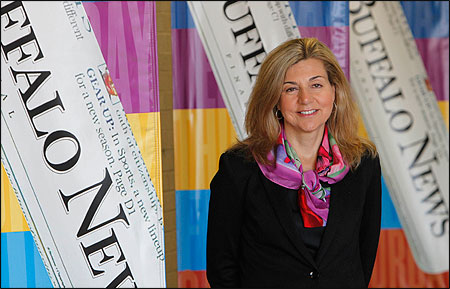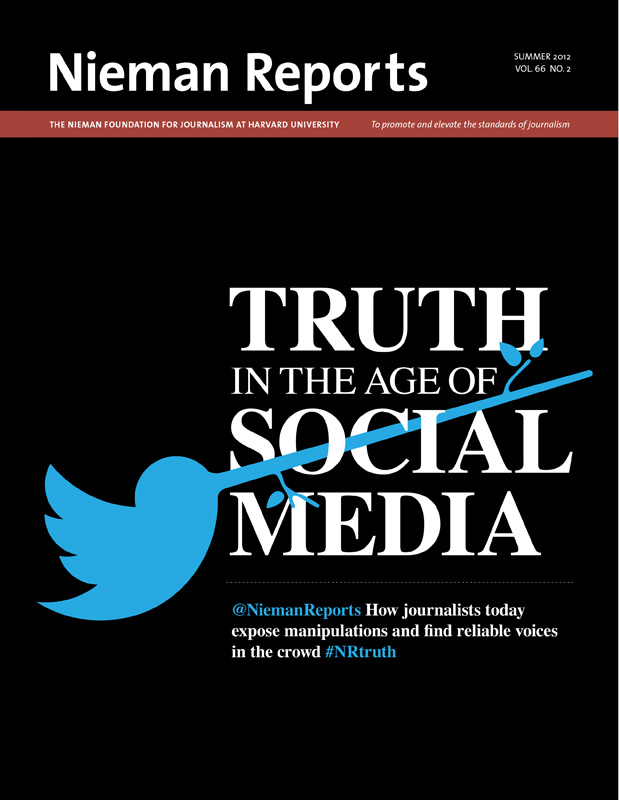
Buffalo News editor Margaret Sullivan drew national media attention for her handling of a controversial story. Photo by Derek Gee/The Buffalo News.
As I watched media coverage of the racially charged shooting death of Trayvon Martin in Florida earlier this year, I found myself thinking about sensitivity and respect. Those issues were big ones for me and The Buffalo News in New York two summers ago.
As Geraldo Rivera of Fox News declared that black teens should avoid wearing hooded sweatshirts and some spectators gleefully welcomed revelations about Martin's less-then-angelic past behavior, all of the questions came flooding back. How can we best avoid blaming the victim? Doesn't the public have the right to know all the facts, not just the ones that support a particular point of view? How do placement and emphasis (in newspaper terms, a front-page headline versus three paragraphs at the end of a story) figure into media decision-making? How does the desire to be provocative (consider Rivera's March 22 tweet: "His hoodie killed Trayvon Martin as surely as George Zimmerman") weigh against responsible commentary and reporting?
As race-oriented stories continue to emerge—and they surely will—those questions deserve to be thought about and talked about in newsrooms. And we can do that most effectively if we broaden the base of those in our conversations, recognizing that diversity is more than numbers; it's the power of what happens when different voices are truly heard. This reality was brought home to me in the aftermath of the furor that erupted in Buffalo's black community over a story the News published in August 2010.
Out of Control
The bloodiest crime in the city's recent history began as a wedding party. Actually, it was a year-after-the-wedding party for a Buffalo couple who had moved to Texas and married there but had come back to celebrate with hometown friends. The setting was City Grill, an upscale restaurant downtown.
The party got rowdy. Then it got out of control, so much so that the proprietors decided to close it down. Bouncers shooed the crowd out onto Main Street. Gunfire blasted out.
By 3 a.m., eight people had been shot. Four of them ultimately died; the others were seriously injured. Among the dead was the 30-year-old bridegroom, Danyell Mackin. His wife, Tanisha, was unhurt.
In the days and weeks that followed the shooting on August 14, 2010, the community's reaction included not only grief and shock but also anger—anger over deep-seated issues involving race and socioeconomic disparity in Buffalo, one of the poorest and most segregated cities in the nation.
All of the victims were black, as was 23-year-old Riccardo McCray, who was eventually convicted of murder and sentenced to life in prison without parole.
One flashpoint for the anger was a story that ran on the front page of the Sunday Buffalo News, eight days after the shooting and on the same day we covered the funeral of one of the victims. Its headline: "7 of 8 shooting victims had criminal past." It reported that five of the victims were convicted felons, with charges including weapons possession, reckless endangerment, drug possession, and armed robbery. 
Click to view larger
The story went to great lengths to make the point that no one intended to blame the victims. The first quote was from a local criminal justice professor who, after noting that a felony prosecution or conviction increases the statistical likelihood of becoming a crime victim, said, "It doesn't mean that the people deserved it or in any way had it coming."
But many members of the black community were enraged. A few days after the story ran, a former gang member turned community activist, Darnell Jackson, led a protest outside the News building, which is less than half a mile from City Grill. One by one, copies of the paper with the controversial article were tossed onto a trash-can fire. He led a similar protest in an East Side backyard. The local TV media covered the criticism of their competition with a certain amount of glee: "Outraged community burns Buffalo News" read the headline on CBS-affiliate WIVB-TV's website.
Soon, the national media was covering the controversy. I found myself on CNN, among other outlets, defending my decision to run the story. For it was my decision. I read it before it ran, and discussed with other editors how and where to display it. I thought the story was important because it helped make sense of what happened that night.
Angry Crowd
As the controversy raged, I made a few phone calls to black leaders in Buffalo to let them know that I was willing to explain my decision and to hear complaints from the black community. One of those leaders was a prominent minister, the Rev. Darius Pridgen. He took me up on my offer and invited me to a community meeting at True Bethel Baptist Church on Buffalo's largely black East Side.
It was not the cozy chat around a table that I had envisioned. Seven hundred angry people filled the church, some holding signs criticizing the paper and me. The meeting had been well publicized and emotions were running high. A lectern with a sound system ensured that everyone in the packed church could hear. Perhaps a dozen speakers preceded me: family members of the victims, ministers, public officials. They all had essentially the same message, and it was directed at me and the newspaper: You've treated us disrespectfully.
"I feel that we were victimized twice," said Cheryl Stevens, whose son-in-law was the bridegroom who died in the shooting. "What you did to us was you poured salt on the wounds that had not even healed."
When Pridgen spoke to the group, he attempted to provide perspective: "This meeting is not designed to be a combat session, but a night of progression. … It is our hope that tonight will not be a one-stop meeting … that this dialogue takes us to another level of understanding and unity in our community."
That evening was one of the most difficult times of my life. The sheer disconnect between a large segment of the community and its newspaper stunned me, as did the depth and intensity of the people's anger.
As I wrote in a News column a few weeks later: "I can say, without exaggeration, that I left that meeting both shaken and changed. I still believe The News was right to publish the story because it exposed an important piece of the puzzle about that tragic shooting. But its timing and placement should have been handled more sensitively and more respectfully."
Reaching Out
Since the City Grill crisis, our newsroom has made a serious effort to forge a stronger connection between the paper and Buffalo's black community. Among other initiatives, we:
- Began a diversity advisory council, made up of community members, that meets with key editors four times a year. Now in its second round of members, the current incarnation includes Darnell Jackson, the leader of the burn-the-News protest. Their perspectives have helped us better understand the community—and they've given us some good story ideas.
- Made a concerted effort to reach out to the black community. We distributed pamphlets explaining how to get stories into the paper and how to contact editors and reporters. We attended community events to speak or just meet people.
- Hired an outside firm to provide diversity awareness training for a large group of editors and reporters.
- Started a regular series of stories highlighting positive aspects of Buffalo's East Side.
Coincidentally, I named Lisa Wilson as executive sports editor; she is, we believe, the only woman of color heading a metropolitan newspaper's sports department. I was deeply grateful throughout the City Grill episode to have the counsel and support of black journalists at the News, several of whom accompanied me to the church meeting. Among them was urban affairs editor and award-winning columnist Rod Watson, now the point person in our community outreach efforts.
There is no question that more diverse newsrooms make for better community coverage. I made a strong diversity-hiring push soon after becoming editor in 1999, increasing minority-group representation to about 14.5 percent of our newsroom's full-time employees, a significant jump from the 7 percent I inherited, but still less than the 20 percent minority population in our major circulation area.
I'm also happy to have named Dawn Marie Bracely as the first black woman on the paper's editorial board and to have other black journalists in key roles. In this era of shrinking newsrooms and little hiring, the push for diversity has been sidetracked throughout the country, but for many reasons it remains crucial to our success.
Is everything all better now in Buffalo? Certainly not. Decades of resentment don't dissipate in a matter of months. But it's fair to say that we've made progress. And the efforts have been noticed. A black reporter on the News's staff, Deidre Williams, attends Darius Pridgen's True Bethel Baptist Church, the scene of my meeting with the black community.
She stopped in to see me a few weeks ago to report that, from the pulpit one Sunday morning, Pridgen explained his decision to sell The Buffalo News in the church vestibule. He held up that day's edition, which included an extensive feature story on Eva Doyle, whose life's work has been teaching black history.
Williams related what Pridgen told his congregation that day: "The Buffalo News said they were going to make some changes, and they have. They kept their word."
Not for a moment do I believe the healing is complete. But we've made a start. I learned a great deal from what happened—that stories are one thing and that people's lives and their feelings are quite another. As journalists, it's hard to make peace between those two competing values, but we have to try.
Margaret Sullivan is the editor of The Buffalo News.



